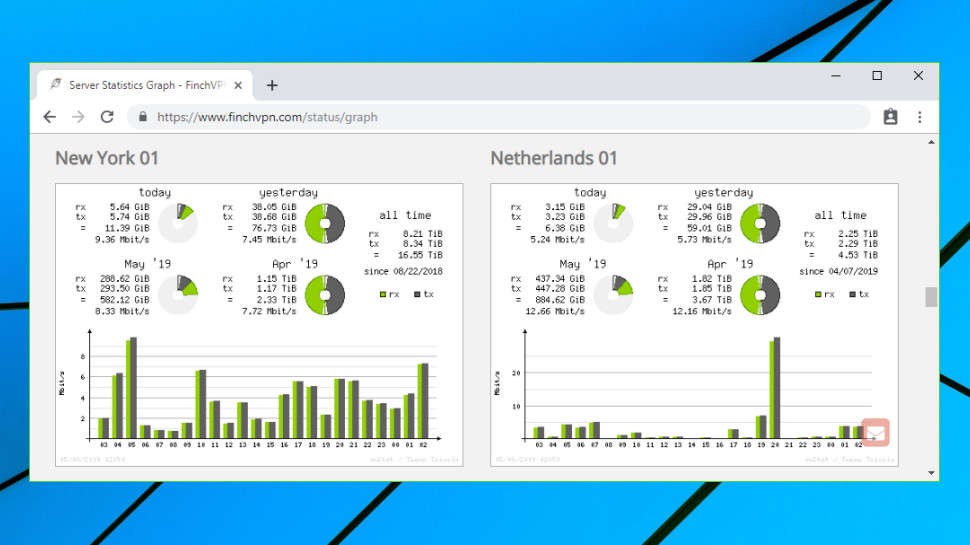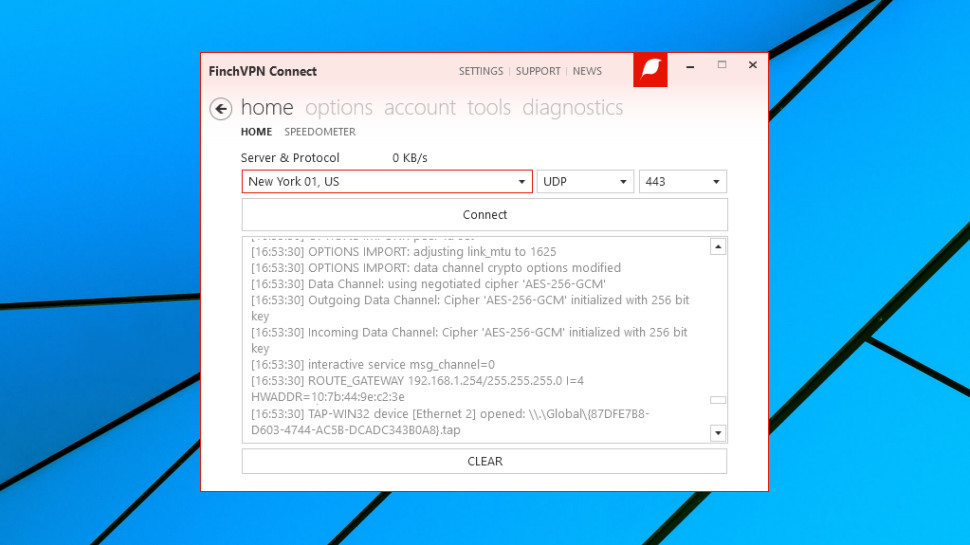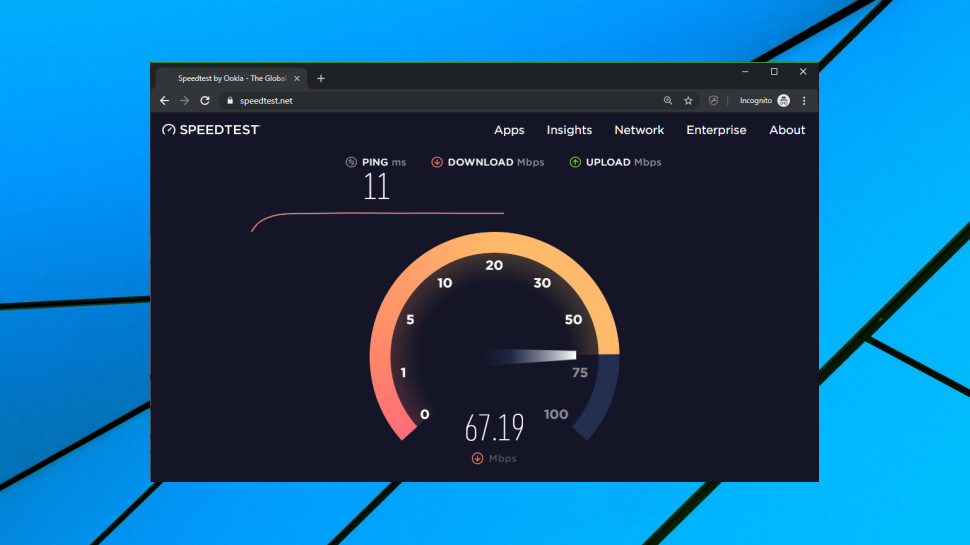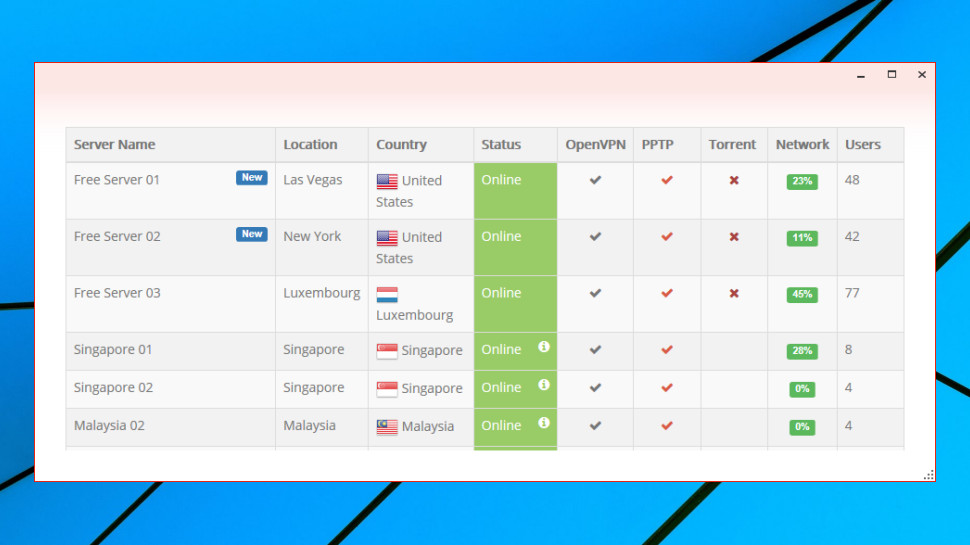TechRadar Verdict
FinchVPN isn't for newbies, but old hands happy to set up the service on third-party apps will get decent performance for a very fair price.
Pros
- +
3GB/ month free plan
- +
Cheap 7-day plan
- +
OpenVPN-compatible
- +
Unblocks US Netflix
Cons
- -
Very few locations
- -
Clumsy, dated Windows client
- -
No Mac, Android, iOS apps
- -
Doesn't unblock iPlayer, Amazon, Disney+
Why you can trust TechRadar
FinchVPN is an extremely simple VPN, horribly short on features. Doesn't sound too appealing, right? But its low prices and free plan might, just possibly, persuade you to give it a try.
The company network is tiny at just 25 servers in 13 locations, but these cover a wider area that you might expect. As well as North America, the UK and Europe, there are servers in Australia, India, Japan, Malaysia, Russia and Singapore. Torrents are supported on some of these.

The FinchVPN website gives an unusual level of detail on server use, with stats on network usage, the number of current users, bandwidth used today, and even a graph showing usage over the past couple of months (click the Graph button top right to see it). It's all very impressive; even giants like ExpressVPN and NordVPN don't have anything similar.
FinchVPN doesn't exactly offer leading-edge technology in other areas. While other providers are now talking about improving speed and security by implementing the WireGuard protocol, the FinchVPN website is still promoting the ancient PPTP, so insecure that many competitors have dropped it entirely. (Fortunately, you can opt to use the much more capable L2TP/IPsec or OpenVPN.)
- Want to try FinchVPN? Check out the website here
You're unlikely to be impressed by FinchVPN's app. Yes, 'app', a basic Windows offering. You can still use the service on Mac, Android, iOS and Linux, but only by setting it up manually (there are tutorials on the support site.)
FinchVPN does have a free plan. This gives you just three locations (US, Netherlands, France), but it comes with 3GB of data a month. That's more generous than the average limited free VPN, although still lagging behind Windscribe's 10GB.
Upgrading to FinchVPN's Pro plan gets you a 25GB data allowance and access to all servers. Very flexible billing enables paying a minimum of $0.50 for 7 days, $1.93 for a month, dropping to an effective $1.82 over 3 months, $1.72 over 6 months and $1.61 on the annual plan.
FinchVPN's Premier plan includes unlimited traffic and adds support for port forwarding, but remains good value at just $1 for 7 days and $3.86 billed monthly, falling to only $3.21 on the annual plan.
There is one catch: the real price varies depending on your payment method. The 7-day Premier Plan only costs $1 if you pay via PerfectMoney; use Google Play or CoinPayments (for cryptocurrencies) and the price jumps to $1.25, opt for PayPal and it's $1.35 (there's no stand-alone card payment option).
While this is annoying, FinchVPN's 7-day plan is still very cheap, and if you only need coverage for a quick trip, it might be a smart choice.
Privacy and logging
FinchVPN's privacy policy is brief, but to the point, explaining that the company does not 'store details of, or monitor, the websites you connect to when using our VPN service.'
There is some session logging, though, as FinchVPN records your connection time, bandwidth used and disconnect time whenever you use the service.
There's no mention of whether the company records incoming or destination IP addresses. If it does, that could be enough to link an IP address associated with an internet action, back to your account. A FAQ page tries to respond to this, but it's not the clearest of answers: 'Our system designed to not tied any specific user details/activities on any specific FinchVPN servers.' Well, okay.
While browsing the small print, we noticed that FinchVPN has a 'strict no-refund policy.' That's not unreasonable for a service with a free plan, but it's still worth keeping in mind. Sign up for 7 days and test FinchVPN carefully before you even think about paying for an annual plan.
Apps
We signed up for FinchVPN, headed off to the Download page, and were surprised to see that the Windows client was last updated more than two years ago. What, users haven't spotted a single bug or requested any new features in all that time? Really?
The surprises continued when we found the download wasn't an installer. Instead, it turned out to be a self-extracting archive which unzipped itself into our folder of choice.

Although this is simple, it can lead to problems. There's no shortcut added to the Start menu, for instance. Of course there's no uninstaller, either. To remove the client, later, you must recognise that you need to uninstall FinchVPN's TAP adapter, handle that, and then delete the FinchVPN files and folders afterwards.
The client interface isn't as polished and novice-friendly as most of the competition. Out go world maps and colorful flags, in comes text-heavy screens with plenty of technical jargon. (How do you want to set your local port binding, for instance? Quickly, now!)
The VPN still works in much the same way as any other - choose a server and click Connect - but the presentation is poor. The location list is a plain text menu, with no data on server load or ping times to help you choose. The connection port is displayed on the main screen, which will probably leave beginners wondering what the default '443' actually means. And when you do click Connect, the client tries to keep you informed by displaying technical OpenVPN status information, like this:
ROUTE: CreateIpForwardEntry succeeded with dwForwardMetric1=35 and dwForwardType=4
Route addition via IPAPI succeeded [adaptive]
Initialization Sequence Completed
We suspect that most users would prefer a simple 'Connected' message.
The status details make it easier to see the encryption FinchVPN is using, though, and this turned out to be AES-256-GCM. Works for us, and a better choice than FinchVPN's outdated PPTP option.
Surprise extras include a number of stealth options (SOCKS, Anti DPI, SSH) which may help you get online in VPN-unfriendly countries.
Despite a number of these more unusual high-end features, FinchVPN falls down on some of the the basics. The client doesn't have a kill switch, for instance, and when we forcibly dropped the VPN connection, it didn't even notice. The interface continued to display our status as Connected, even though the VPN was down, and we were using our regular, unprotected connection.

Performance
Opting for a free VPN usually means poor performance, but not with FinchVPN. Our nearest Netherlands server managed 45-55Mbps, and even UK-US connections reached a decent 30-35Mbps.
The paid plan wasn't much faster. It gave us access to a UK server, for instance, but that still only got us up to 60-65Mbps.
We ran a final check from a server in a European data center, to see exactly how fast FinchVPN could go. The answer turned out to be 'not very', as our 800Mbps regular connection speeds fell to 60-80Mbps when we turned on the VPN. That's far from a disaster, though, and there's more than enough speed here for regular tasks.
The FinchVPN website claims it allows you to 'enjoy BBC iPlayer and other online TV when traveling outside the US and UK', but that's not what we found. The service left us locked out of iPlayer, Amazon Prime Video and Disney+, although it did get us access to US Netflix.
We completed the review by looking for privacy problems, and DNSLeakTest, DoILeak and other test sites confirmed the FinchVPN client had a DNS leak. FinchVPN's configurability means expert users may be able to fix this themselves (we did it by adding block-outside-dns to the Custom OpenVPN Config box), but that shouldn't be necessary - life would be much easier if the client correctly blocked DNS leaks itself.
Final verdict
FinchVPN desperately needs more locations, and more and better apps. But the 3GB/ month free plan is fair, speeds are better than we expected, and 7-day plans are cheap. We wouldn't use it for anything serious, but FinchVPN could work as a simple backup VPN for short trips.
- We've also highlighted the best VPN

Mike is a lead security reviewer at Future, where he stress-tests VPNs, antivirus and more to find out which services are sure to keep you safe, and which are best avoided. Mike began his career as a lead software developer in the engineering world, where his creations were used by big-name companies from Rolls Royce to British Nuclear Fuels and British Aerospace. The early PC viruses caught Mike's attention, and he developed an interest in analyzing malware, and learning the low-level technical details of how Windows and network security work under the hood.
